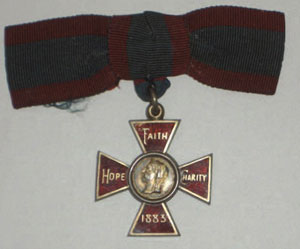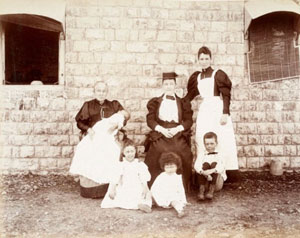By Peter W. Halligan

Teresa McGrath (1865–1907) was awarded the Royal Red Cross in 1899 for her exceptional bravery in nursing wounded soldiers of the 36th (Sikh) Regiment of Bengal Infantry at the siege of Fort Gulistan in September 1897. The Royal Red Cross is the highest military decoration awarded to nurses who show exceptional acts of bravery and devotion in military nursing. Teresa’s award was unusual in that she was not a military nurse but worked as a nanny looking after the children of the commanding officer. The award recognised her nursing of the dying and wounded Sikh soldiers ‘with unceasing care and courage’ when Fort Gulistan was attacked by thousands of Pashtun tribesmen.
BACKGROUND
Born in June 1865 at Thornberry, near Kill, Co. Kildare, Teresa was the seventh child of Philip McGrath (1825–77) and Maria Halligan (1835–1906). In 1885, at the age of twenty, she followed her older sister Julia out to Brisbane, Australia, where she became a nursemaid to the children of Major Charles Hamilton Des Voeux, a young Irish officer from Portarlington, Co. Laois, serving in Australia’s Queensland Defence Force before moving to join the 36th Sikh Regiment of the Bengal Infantry in the North West Frontier province of British India in 1891.
In the late nineteenth century, British forces held several defensive forts along the Samana mountain ridge on the colonial border between British India and Afghanistan; increasing attacks by Afridi and Orakzai tribes were provoked by British plans to redefine the border, which the tribes saw as an encroachment on their lands. In 1897 Major Des Voeux was the commanding officer of the 36th Sikhs based at Fort Gulistan, together with his pregnant wife Eleanor, his three children and Teresa McGrath, the children’s nanny.
On 12 September 1897, an estimated 10,000 Pashtun tribesmen rose in rebellion, cutting off the small communications outpost of Saragarhi, 2km from Fort Gulistan. Twenty-one soldiers of the 36th Sikhs subsequently died defending this small fortress, giving the nearby forts time to send for reinforcements and prepare their defences. Each of the 21 soldiers who took part in the engagement was posthumously awarded the Indian Order of Merit, the highest award given to Indian soldiers at the time.

FORT GULISTAN
Having successfully destroyed Saragarhi, the Afghans focused their efforts on destroying the garrison at Fort Gulistan. Heavy fighting ensued over three days, during which Mrs Des Voeux gave birth to a baby girl. Throughout the fighting, casualties were looked after by Surgeon Captain Prall and Teresa McGrath. Despite substantial casualties, the Sikhs at Fort Gulistan managed to hold out until support arrived three days later from the 3rd Bengal Cavalry, driving off the attacks.
Although most newspaper reports from India, Australia and the UK praised the incredible bravery of the 21 Sikhs who died at Saragarhi, they also highlighted the exemplary courage of Teresa McGrath, a civilian nanny, who during the attacks on Fort Gulistan cared for more than 40 injured soldiers while under heavy fire and while also looking after Mrs Des Voeux and her four young children. Teresa’s heroism was widely reported in the Australian, British and Irish newspapers, such as the London Gazette, the Westminster Gazette, the Illustrated London News, the Freeman’s Journal, the Kildare Observer, the Brisbane Courier Mail, the Daily Chronicle and the Times.
REPORTS OF HER BRAVERY
Writing in the Brisbane Courier Mail on 18 September 1897, Major Des Voeux highlighted the gallantry of his Sikh soldiers but also praised the role played by Teresa McGrath, noting that she ‘surpassed herself attending to the sick and wounded. Her name has gone forward for reward, and I hope she will get it. She will certainly get the medal and probably an order.’ Col. Haughton, the commanding officer of the 36th Sikhs and Des Voeux’s superior, wrote that
‘Surgeon-Captain Prall had untiringly tended the wounded under heavy fire, helped by Miss Teresa McGrath, Mrs. Des Voeux’s maid, who amid the flying bullets could be seen here bathing a wounded sepoy’s head and there tying up another’s arm till the doctor could come.’
He went on to say that

‘Teresa has been simply splendid, looking after the children and baking bread by day and looking after Mr. Blair at night, besides superintending food for both patients. She has been as plucky and cheery as possible, and on more than one occasion ran down, under fire, from the fort to the hornwork [a type of fortification with angular points or horns enclosing an area] to get things wanted.’
By 1898 there was growing pressure for the granting of an award, with the Daily Chronicle calling for women who showed conspicuous courage and self-sacrifice to receive the Victoria Cross itself. It cited the example of Teresa, who at
‘… a time when the stoutest man’s nerves were shaken, Miss McGrath, by her courage and presence of mind, saved many of the garrison from bleeding to death. As well as enduring all the hardships of the siege, Miss McGrath nursed the dying and wounded night and day with unceasing care and courage but has received no recognition whatever of her devotion and heroism.’
ROYAL RED CROSS
The Royal Red Cross was awarded to Teresa in person by Queen Victoria at Windsor Castle on 11 May 1899, together with the India Campaign Medals, a decoration given to all those who served on the Samana and Tirah expeditions in north-west India (1895–1902). This was the first time the war medals had been conferred on a woman.
After her award, Teresa continued her duties with the Des Voeux family back in England. In 1907 she returned to India, where she married Drum Major George Lawrence of the Second Gordon Highlanders, Peshawar, in February 1907. Sadly, her marriage was short-lived. She died from malarial fever on 4 December 1907 in Peshawar and was buried in the Jamrud Road Cemetery, some 50 miles from the heroic events of September 1897 at Fort Gulistan. More than 120 years later, the courage of the 21 Sikh soldiers at Saragarhi and Teresa’s bravery at Fort Gulistan have become the subjects of books, articles, documentaries and two major films, suggesting that Teresa’s heroism is better known abroad than in Ireland.
Peter W. Halligan is an Honorary Professor in the School of Psychology at Cardiff University.
Further reading
Capt. J. Singh-Sohal, ‘The battle of Saragarhi: when 21 Sikh soldiers stood against 10,000 men’, https://www.historyextra.com/period/victorian/when-21-sikh-soldiers-stood-against-10000-men-the-battle-of-saragarhi/ (BBC History Magazine, 19 August 2019).
The author acknowledges the family research uncovered by Janet and Joe Halligan.
